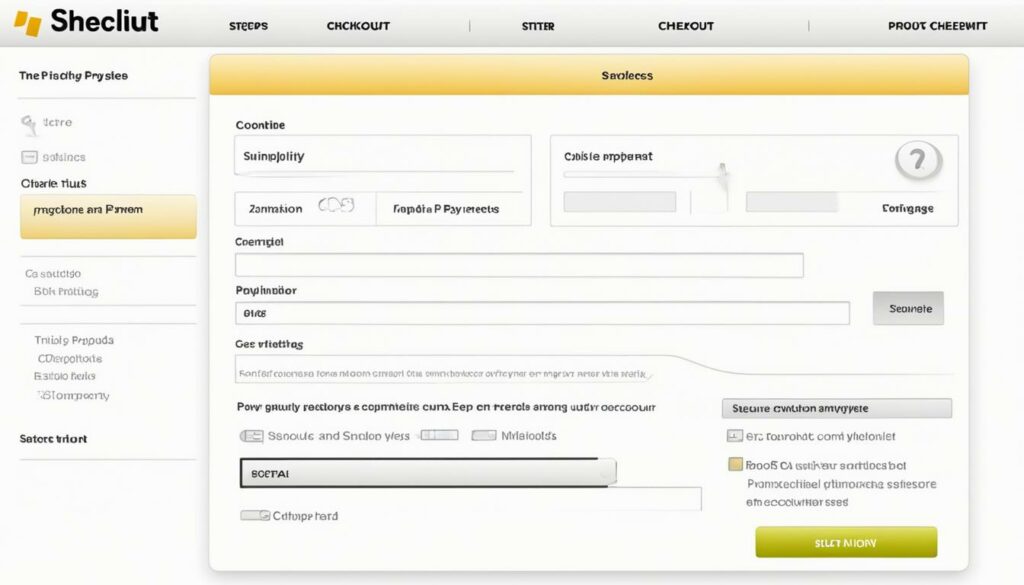The shopping cart abandonment rate is a critical metric in ecommerce that quantifies the percentage of online shoppers who add items to their virtual shopping carts but leave the website without completing the purchase. It serves as an important indicator of the number of potential customers who are leaving without converting, highlighting the need for improvement in the ecommerce buying experience.
According to the Baymard Institute, the average shopping cart abandonment rate stands at 69.99%. This means that only three out of ten customers who add items to their carts proceed to checkout, leaving ample room for improvement. The abandonment rate has been steadily increasing since 2014, making it crucial for online retailers to find ways to reduce cart abandonment and increase their conversion rates.
Lowering the cart abandonment rate is key to improving the overall performance of an ecommerce website. By addressing the causes of cart abandonment and optimizing the buying journey, online retailers have the potential to increase revenue and boost customer satisfaction.
Key Takeaways
- The shopping cart abandonment rate measures the percentage of customers who add items to their carts but fail to complete the purchase.
- The average shopping cart abandonment rate is 69.99%, indicating a need for improvement in the ecommerce buying experience.
- To reduce cart abandonment, online retailers can employ strategies such as enhancing trust, simplifying the checkout process, and offering incentives like free shipping.
- Understanding customer behavior and preferences can help tailor strategies to reduce cart abandonment and improve the conversion rate.
- The shopping cart abandonment rate is closely related to other ecommerce metrics and can provide valuable insights when analyzed in conjunction.
Calculating Shopping Cart Abandonment Rate
Calculating the shopping cart abandonment rate is essential for online retailers to gain insights into the shopping behavior of their visitors and customers. This metric provides valuable information on how intuitive and trustworthy the checkout process is, helping identify areas for improvement. To calculate the abandonment rate, follow these steps:
- Divide the total number of completed purchases by the number of shopping carts created.
- Subtract the result from one.
- Multiply the difference by 100 to get the abandonment rate as a percentage.
For example, let’s consider a scenario where there are 45 completed purchases and 200 shopping carts created.
Abandonment rate = (1 – (45/200)) * 100 = 77.5%
This calculation indicates that 77.5% of shoppers who added items to their cart did not complete the purchase.
By regularly calculating and tracking the shopping cart abandonment rate, online retailers can gain a comprehensive understanding of their website’s performance and make informed decisions to optimize the checkout process.
Example Calculation:
| Total Completed Purchases | Total Shopping Carts Created | Abandonment Rate |
|---|---|---|
| 45 | 200 | 77.5% |
Table 1: Example calculation of shopping cart abandonment rate.

Importance of Shopping Cart Abandonment Rate in Ecommerce
The shopping cart abandonment rate is a crucial metric for ecommerce sites. It provides valuable insights into the effectiveness of the online shopping experience and can significantly impact conversion rates. By understanding and addressing the reasons behind high cart abandonment rates, online retailers can optimize their websites and increase their revenue.
When customers abandon their shopping carts, it indicates that something might be preventing them from completing their purchase. There are several common issues that can contribute to high abandonment rates. These include:
- Complex or time-consuming checkout process: If the checkout process is cumbersome or lengthy, customers may abandon their carts in frustration.
- Lack of trust: If customers have doubts about the security of their personal information or the reliability of the website, they may hesitate to complete the purchase.
- High shipping costs: Unexpected or high shipping costs can deter customers from finalizing their purchase.
- Limited payment options: If customers’ preferred payment methods are not available, they may abandon their carts.
By tracking and analyzing the shopping cart abandonment rate, online retailers gain valuable insights into these issues and can take steps to improve the conversion rate. Reducing cart abandonment can lead to increased revenue and improved overall performance of the ecommerce website.
To optimize the conversion rate and address high cart abandonment, online retailers can implement various strategies. These strategies include:
- Simplifying the checkout process: Streamlining the checkout process to make it quick, intuitive, and user-friendly can significantly reduce cart abandonment.
- Building trust: Incorporating trust elements, such as security badges, customer reviews, and testimonials, can help instill confidence in customers and encourage them to complete their purchase.
- Offering free shipping or promotions: Providing incentives like free shipping or limited-time promotions can persuade customers to proceed with their purchase.
- Offering multiple payment options: Giving customers the flexibility to choose their preferred payment method can increase the likelihood of completing the purchase.
- Implementing cart recovery tactics: Sending abandoned cart emails and using retargeting ads can remind customers about their pending purchases and encourage them to revisit the website.
By carefully analyzing customer behavior, implementing these strategies, and continuously monitoring the shopping cart abandonment rate, online retailers can optimize their websites for improved conversion rates and overall success in the ecommerce industry.
Impact of Improving Shopping Cart Abandonment Rate on Conversion Rate
| Cart Abandonment Rate | Conversion Rate |
|---|---|
| 70% | 2% |
| 50% | 3% |
| 30% | 4% |
| 10% | 5% |
The table above demonstrates the impact of improving the shopping cart abandonment rate on the conversion rate. As the cart abandonment rate decreases, the conversion rate tends to increase. For example, a decrease from 70% to 10% in the cart abandonment rate can lead to a significant increase in the conversion rate from 2% to 5%. This highlights the importance of reducing cart abandonment and optimizing the ecommerce conversion rate.
Strategies to Improve Shopping Cart Abandonment Rate
Online retailers can implement several effective strategies to reduce shopping cart abandonment and improve conversion rates. By addressing the underlying factors that contribute to cart abandonment, retailers can encourage customers to complete their purchases and optimize their online shopping experience.
Enhance Website Trustworthiness
To instill trust in customers, incorporate trust seals and customer reviews throughout the website. Trust seals from reputable security companies can assure customers that their personal and financial information is protected. Positive customer reviews and testimonials can also help build trust and confidence in the reliability of your products and services.
Incentivize Customers
Offering free shipping or limited-time promotions can be powerful incentives for customers to complete their purchases. These incentives create a sense of urgency and value, making customers more likely to proceed to checkout without abandoning their carts.
Simplify the Checkout Process
A complex and confusing checkout process can be a major deterrent for customers. Simplify the process by reducing the number of steps, eliminating unnecessary form fields, and providing clear instructions and progress indicators. A streamlined and intuitive checkout process enhances the overall user experience and reduces friction, increasing the likelihood of conversion.
Provide Multiple Payment Options
Customers have different preferences when it comes to payment methods. By offering a variety of payment options such as credit cards, PayPal, and digital wallets, you can cater to the preferences of a wider range of customers. This flexibility increases the chances of customers completing their purchases instead of abandoning their carts due to limited payment options.
Implement Cart Recovery Tactics
Cart recovery tactics such as abandoned cart emails and retargeting ads can help recapture lost sales. Send personalized emails to customers who have abandoned their carts, reminding them of the items they left behind and offering incentives to complete their purchase. Retargeting ads can also remind customers about their abandoned carts when they visit other websites, increasing the chances of conversion.

Incorporating these strategies and continuously testing and optimizing them can significantly reduce shopping cart abandonment and improve conversion rates. By addressing the root causes of abandonment and providing a seamless and enticing shopping experience, online retailers can maximize their revenue potential and increase customer satisfaction.
Customer Behavior and Shopping Cart Abandonment
Customer behavior is a key factor in understanding and addressing shopping cart abandonment. Various elements, including product type, traffic source, location, age, and the time of month or year, can influence the likelihood of customers abandoning their carts. It is important to recognize that customers may be more inclined to abandon their carts when purchasing higher-priced items or non-essential products. Furthermore, the source of traffic, whether it’s from social media or search engines, can impact cart abandonment rates. Additionally, specific age groups, particularly those between 25 and 44, tend to exhibit higher cart abandonment rates.
By gaining a deeper understanding of customer behavior and preferences through user research and analytics, online retailers can tailor their strategies to reduce cart abandonment and improve the conversion rate. This valuable insight allows businesses to address customer concerns and eliminate potential barriers that prevent customers from completing their purchases. Implementing targeted solutions based on customer behavior analysis can greatly enhance the overall shopping experience and increase the likelihood of conversion.
For example, knowing that customers tend to abandon carts when purchasing higher-priced items, retailers can consider offering financing options to alleviate payment concerns. By monitoring and analyzing user behavior, online retailers can identify pain points in the shopping journey, such as complex checkout processes or confusing navigation, and make necessary improvements.
Factors Influencing Cart Abandonment:
- Product type
- Traffic source
- Location
- Age
- Time of month/year
| Age Group | Cart Abandonment Rate |
|---|---|
| 18-24 | 65% |
| 25-34 | 70% |
| 35-44 | 75% |
| 45-54 | 68% |
| 55+ | 62% |

Shopping Cart Abandonment Rate and Other Metrics
The shopping cart abandonment rate is an important metric for ecommerce sites, but it is not the only metric that online retailers should focus on. To truly understand the performance of their website and improve conversion rates, it is crucial to analyze the shopping cart abandonment rate in relation to other key metrics.
One such metric is the average order value (AOV), which represents the average amount spent by customers in a single transaction. A high shopping cart abandonment rate coupled with a low AOV may indicate that customers are adding low-value items to their carts and then leaving without making a purchase. In this case, retailers could consider implementing strategies to upsell or cross-sell to increase the AOV and encourage customers to complete their purchases.
Gross profit margin is another metric that can provide insights into the impact of shopping cart abandonment on overall profitability. If the abandonment rate is high and the profit margin is low, it may be necessary to reevaluate pricing strategies or explore cost-saving measures to maintain profitability despite potential revenue loss from abandoned carts.
The website conversion rate is a critical metric for measuring the success of an ecommerce website in turning visitors into customers. A high abandonment rate can negatively impact the conversion rate, highlighting the need to optimize the checkout process and improve the overall user experience. By streamlining the checkout process and removing any friction points that may cause customers to abandon their carts, online retailers can increase the conversion rate and ultimately boost revenue.
Website speed and uptime are additional metrics that can contribute to shopping cart abandonment. Slow-loading pages or frequent website downtimes can frustrate shoppers and lead them to abandon their carts. Ensuring that the website is fast, reliable, and accessible is crucial for providing a smooth and seamless shopping experience.

Comparison of Shopping Cart Abandonment Rate and Other Metrics
| Metric | Definition | Impact on Shopping Cart Abandonment Rate |
|---|---|---|
| Average Order Value (AOV) | The average amount spent by customers in a single transaction | A low AOV coupled with a high abandonment rate may indicate low-value items being abandoned |
| Gross Profit Margin | The difference between revenue and the cost of goods sold, expressed as a percentage | A low profit margin combined with a high abandonment rate may require pricing or cost-saving adjustments |
| Website Conversion Rate | The percentage of website visitors who complete a desired action, such as making a purchase | A high abandonment rate can negatively impact the conversion rate and signify the need for checkout optimization |
| Website Speed and Uptime | The loading time and availability of the website | Slow-loading pages or frequent downtimes can aggravate shoppers and contribute to cart abandonment |
By considering the relationship between shopping cart abandonment rate and other key metrics, online retailers can gain a deeper understanding of their website’s performance and identify areas for improvement. Optimizing the checkout process, improving average order value, managing profit margins, and maintaining website speed and uptime can all contribute to reducing cart abandonment and driving higher conversion rates.
Challenges and Considerations in Addressing Shopping Cart Abandonment
Reducing shopping cart abandonment is a top priority for online retailers aiming to improve conversion rates. However, it is important to understand and address the challenges and considerations that come with tackling this issue.
One of the greatest challenges in reducing shopping cart abandonment is the complexity of the problem. There are various reasons why customers abandon their carts, and there is no one-size-fits-all solution. It requires a thorough analysis of customer behavior, testing different strategies, and optimizing the checkout process to identify the specific causes and implement effective solutions.
Furthermore, online retailers must consider several factors that contribute to cart abandonment. Building trust is key, as customers need to feel secure when making an online purchase. Pricing also plays a crucial role, as unexpected fees or high shipping costs can deter customers. Moreover, the user experience should be seamless and intuitive, allowing customers to complete their purchase quickly and easily. Technical issues, such as slow page load times or checkout errors, can also contribute to cart abandonment and need to be addressed.
By embracing these challenges and considering the unique aspects of their business, online retailers can make significant improvements in reducing cart abandonment and increasing conversions. It requires a well-rounded approach that prioritizes customer trust, pricing transparency, user experience optimization, and technical functionality. By continuously analyzing and optimizing the checkout process, online retailers can overcome these challenges and create a seamless shopping experience that encourages customers to complete their purchases.
FAQ
What is Shopping Cart Abandonment Rate in Ecommerce?
Shopping cart abandonment rate is the percentage of online shoppers who add items to their virtual shopping carts but then leave the website without completing the purchase.
How do you calculate Shopping Cart Abandonment Rate?
The shopping cart abandonment rate is calculated by dividing the total number of completed purchases by the number of shopping carts created, then subtracting the result from one and multiplying by 100.
Why is the Shopping Cart Abandonment Rate important in Ecommerce?
The shopping cart abandonment rate is an important metric for ecommerce sites because it indicates how many potential customers are leaving without converting. It helps online retailers understand the shopping behavior of their visitors and customers and is an indication of how intuitive and trustworthy the checkout process is.
What are some strategies to improve the Shopping Cart Abandonment Rate?
Strategies to improve shopping cart abandonment rate include enhancing website trustworthiness, offering incentives, simplifying the checkout process, providing multiple payment options, and implementing cart recovery tactics such as abandoned cart emails and retargeting ads.
How does customer behavior affect Shopping Cart Abandonment?
Customer behavior plays a significant role in shopping cart abandonment. Factors such as the type of products, traffic source, location, age, and time of the month and year can influence the likelihood of cart abandonment. Understanding customer behavior and preferences can help online retailers tailor their strategies to reduce cart abandonment and improve the conversion rate.
How does Shopping Cart Abandonment Rate relate to other metrics?
The shopping cart abandonment rate is closely related to other ecommerce metrics such as average order value, gross profit margin, website conversion rate, and website speed or uptime. By optimizing the checkout process to reduce cart abandonment, online retailers can increase the overall efficiency of their website and improve the conversion rate.
What are some challenges and considerations in addressing Shopping Cart Abandonment?
Challenges in reducing shopping cart abandonment include the complexity of the issue and the need for careful analysis, testing, and optimization. Online retailers also need to consider factors such as trust, pricing, user experience, and technical issues that may contribute to cart abandonment.
